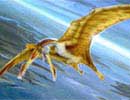 Scientists have recently discovered that the giant reptiles that soared through the skies approximately 65 million years ago were twice as large as previously thought, with wingspans of at least 18 meters.
Scientists have recently discovered that the giant reptiles that soared through the skies approximately 65 million years ago were twice as large as previously thought, with wingspans of at least 18 meters.
This size is comparable to the fully extended wingspan of an F-14 fighter jet and five times that of a seagull, one of the birds with the widest wingspans in the modern world.
Dr. David Martill from the University of Portsmouth in southern England stated that his research could help answer the question of how these enormous creatures were able to fly and dominate the skies.
Martill reported finding distinct fossilized footprints in Mexico that indicate they belonged to a creature with an 18-meter wingspan. “Although they are just fragmented pieces, they are extremely large fragments. We also found impressive toe bones with significant diameters.”
Despite their size, the bone structure and tissue of the flying lizard’s wings suggest they were adept flyers. The wing membrane is remarkably thin, measuring about half a millimeter. The wings are more bat-like than bird-like, featuring hollow bones and a body not much larger than a human’s, which helped reduce weight.
Additionally, their wings are locked at the tail rather than at the top of the body, creating a large surface area that takes advantage of rising warm air to glide gracefully through the skies.
The bulkier part of their body is the neck, which stretches up to 3 meters and is connected to a skull that is 2 meters long. While this may not have been very convenient for flying, this feature allowed the creature to hunt over the sea without needing to dive down.
Martill suggests that one reason for their enormous size is that they continued to grow without stopping at a certain size during adulthood.


















































